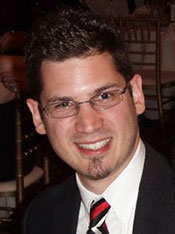The Department of Kinesiology and Community Health
College of Applied Health Sciences
Side Navigation
Jacob Sosnoff
Assistant Professor
Kinesiology and Community Health

Jacob Sosnoff was close to his grandfather, who suffered from post-polio syndrome, a weakening of muscles in survivors of polio years after their acute infection. His family's business is in prosthetics and orthotics, so he was exposed to movement and movement disorders from a young age. In fact, one of his earliest memories is delivering an artificial limb with his father, and watching his father fit the prosthetic. "I was four years old, and this guy handed his leg to me. I always remember being amazed by that," Dr. Sosnoff said. Little wonder, then, that his research focuses on the influence of aging, chronic illness, and disability on motor control.
Dr. Sosnoff joined the Department of Kinesiology and Community Health at Illinois after completing his doctoral degree in kinesiology at The Pennsylvania State University. Within his Motor Control Laboratory, he has collaborated with Torrey Loucks of the Department of Speech and Hearing Science in an examination of the relationship between oral muscles of the face and manual dexterity. As people age, Dr. Sosnoff explains, the brain loses neurons, and other neurons may pick up their function. Seemingly disparate movements can become more closely linked. The researchers have taken baseline measures in young, healthy adults, and will make measurements in older adults who are healthy and who have Parkinson’s disease and multiple sclerosis.
"We expect to see tighter coupling between areas of fine motor control, or dedifferentiation—the loss of specialization in form or function," he said. "Our hope is to develop a potential screening device for early warning signs of Parkinson's or multiple sclerosis."
Dr. Sosnoff also is interested in identifying new factors that contribute to shoulder pain in wheelchair users. Through his research, he has found that timing variability in wheelchair propulsion has the same pattern as walking. As people age and slow down, the amount of time that elapses between steps increases. He believes this discovery provides a new theoretical framework for looking at the problem of shoulder pain in wheelchair users. He is also applying the theory of overuse injury in running, which says that using the same gait pattern over time wears parts of the knee out, to wheelchair propulsion. Ultimately, he hopes to identify ways to extend the health of shoulders in wheelchair users.
